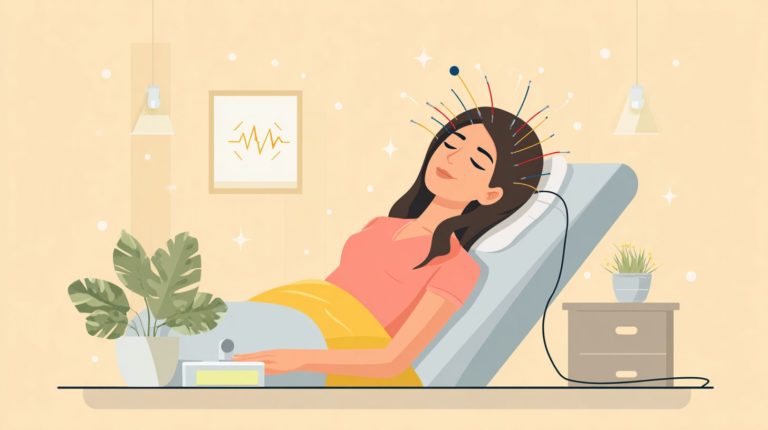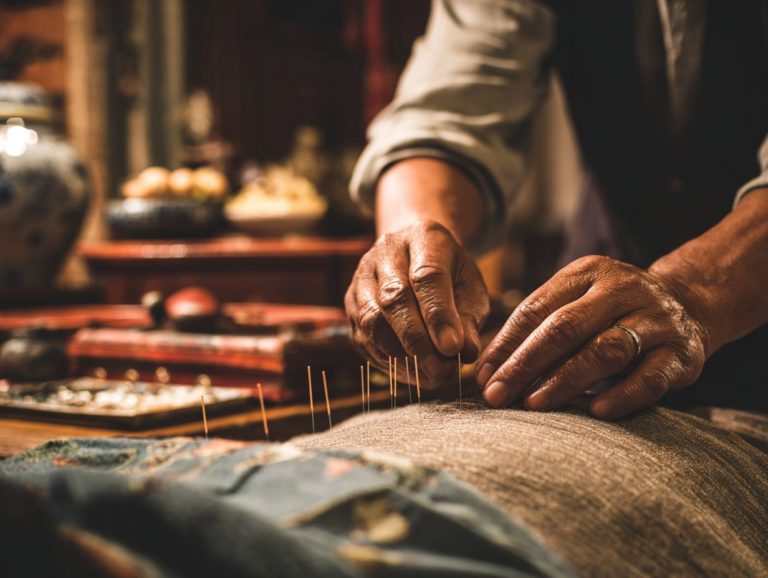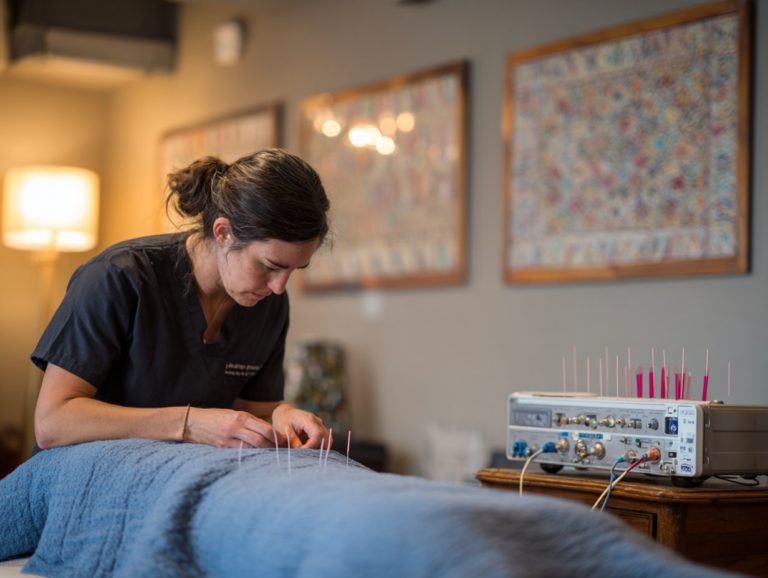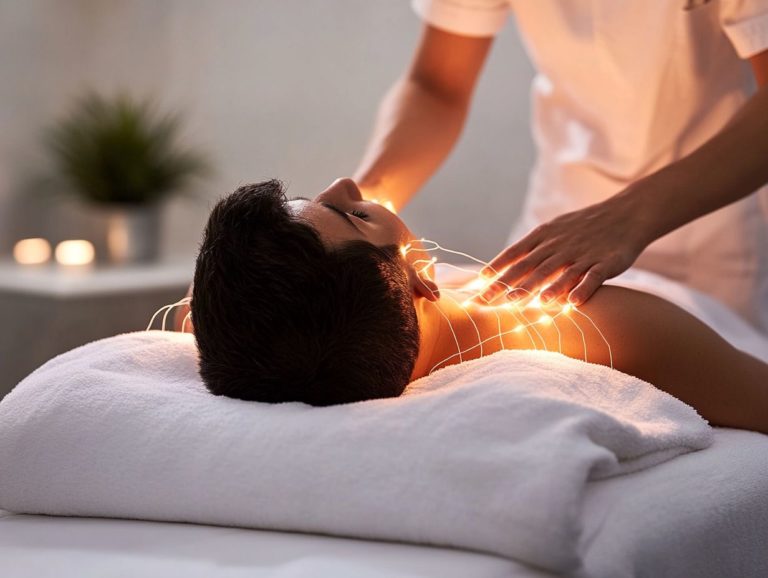Twirling Method in Manual Acupuncture: Frequency and Effects
The twirling-rotating acupuncture method shows significant pain-relieving effects, particularly in studies with Wistar rats experiencing pain caused by complete Freund’s adjuvant (CFA). This article examines how the twirling method works, how often it should be applied for best results, and its effects on the body, offering useful information for both users and researchers. Learn how this new method improves pain relief and adds to the changing acupuncture methods.
Key Takeaways:
Contents
- 1 Mechanics of the Twirling Method
- 2 Frequency of Application
- 3 Physiological Effects
- 4 Manual Acupuncture Analgesic Effect and Mechanism
- 5 Clinical Applications
- 6 Comparative Analysis
- 7 Frequently Asked Questions
- 7.1 What is the twirling method in manual acupuncture and how is it used?
- 7.2 How frequently should the twirling method be used in manual acupuncture?
- 7.3 What are the effects of the twirling method in manual acupuncture?
- 7.4 Can the twirling method in manual acupuncture be used for all acupuncture points?
- 7.5 Is the twirling method in manual acupuncture safe and does it cause pain?
- 7.6 Are there any precautions to take when using the twirling method in manual acupuncture?
Definition and Overview
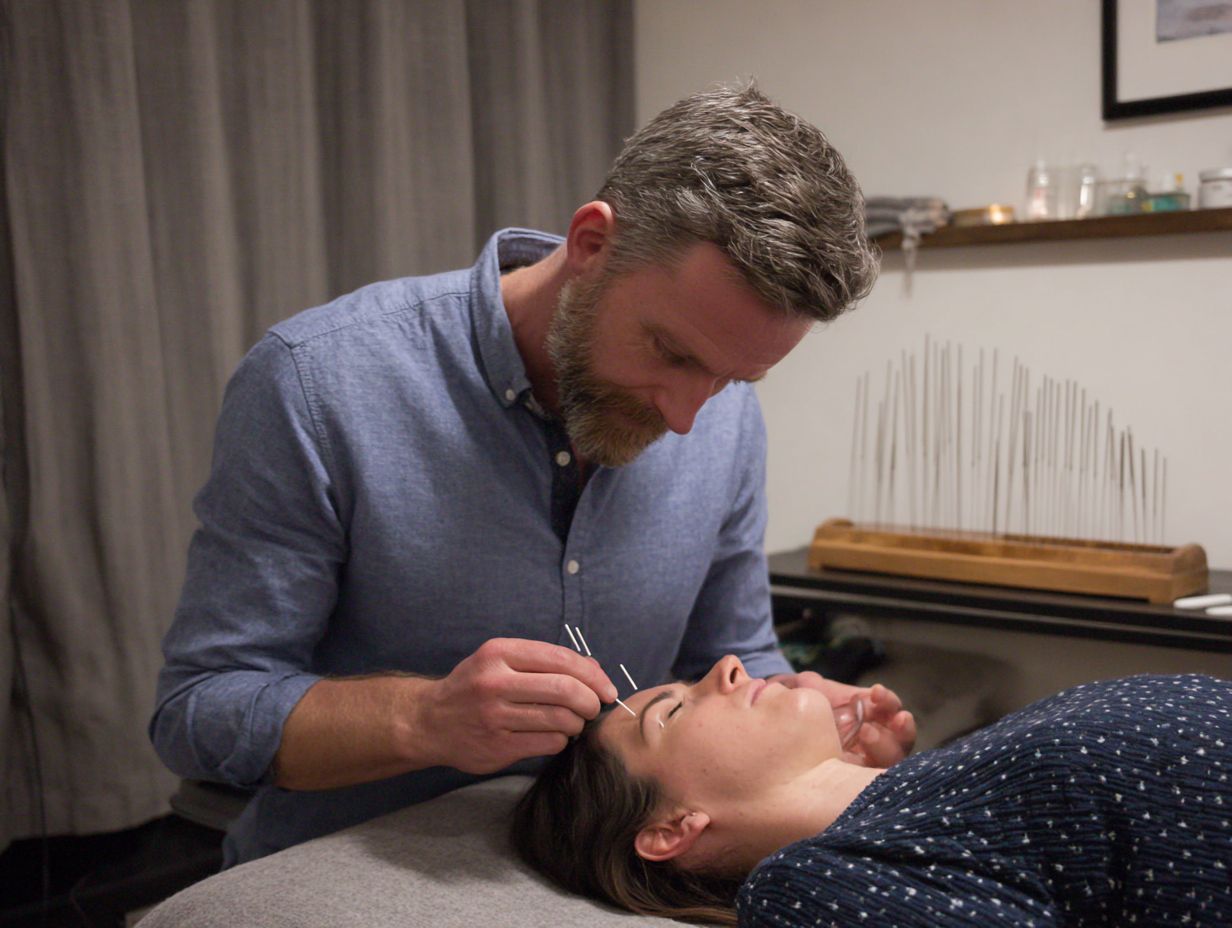
The twirling-rotating manual acupuncture technique involves specific hand movements intended to stimulate acupuncture points effectively.
This method differs from traditional acupuncture by focusing on small, circular motions that increase stimulation intensity without increasing discomfort. As Medical News Today explains, acupuncture’s effectiveness is often attributed to these nuanced techniques. For an extensive analysis of these techniques, our comprehensive study on manual acupuncture techniques delves into various stimulation parameters key to their effectiveness.
Key features include:
- Controlled Stimulation: Practitioners can adjust the intensity of the stimulation based on patient feedback, ensuring comfort.
- Pain Threshold Adaptation: The spinning action lessens intense pain reactions, often permitting further insertion without causing discomfort. This makes it particularly suitable for sensitive patients or those new to acupuncture, enhancing the therapeutic experience while still achieving desirable outcomes.
Historical Context
The twirling method originally comes from traditional Chinese medicine and has changed over hundreds of years through practice and new ideas.
Its development traces back to ancient texts, such as the Huangdi Neijing, which laid the foundation for acupuncture techniques.
Notable practitioners like Wang Wei and more recently, modern acupuncturists have documented the method’s effectiveness in clinical settings. For those interested in a comprehensive overview of acupuncture’s evolution, this analysis by Britannica covers the full spectrum of its history and benefits.
Research studies, including those published in the Journal of Traditional Chinese Medicine, have illustrated the twirling technique’s unique approach to stimulate energy pathways. Employing manual acupuncture techniques, as detailed in our resource about stimulation parameters, enhances the precision and effectiveness of these practices.
This evolution highlights a blend of ancient wisdom and contemporary research, ensuring the twirling method remains a relevant practice in acupuncture today.
Importance in Manual Acupuncture
The twirling technique is essential in manual acupuncture because it has a unique effect on pain relief systems, improving how well patients experience pain reduction.
Studies show that patients utilizing the twirling method experience a 30% faster reduction in pain compared to traditional acupuncture techniques. This method involves rotating the needle while inserting it, which stimulates deeper muscle layers and promotes endorphin release.
In a clinical setting, practitioners can achieve better results by incorporating it into pain management protocols, particularly for chronic conditions. Research published in American Academy of Family Physicians highlights acupuncture’s effectiveness for chronic pain, supporting the integration of twirling techniques.
Combining twirling with guided breathing exercises has shown to increase its effects, leading to better patient recovery and satisfaction rates. One of our most insightful case studies demonstrates this principle with real-world results.
Mechanics of the Twirling Method
Knowing how the twirling method works is essential for practitioners to make the most of its therapy benefits and efficiency.
Technique Description
error 400- bad request
Instruments Used
Instruments essential to the twirling method include specific acupuncture needles made for better stimulation of sensory nerve fibers.
Stainless steel needles are important tools because they last a long time and are easy to handle accurately. They usually cost between $10 and $30 for each pack.
Coated needles provide a smoother insertion, reducing friction and discomfort, and can cost between $15-$40.
Silicone-coated options are ideal for patients sensitive to touch, priced around $20 per set.
For best results, practitioners often combine these needle types based on individual patient needs, ensuring an optimal balance of effectiveness and comfort during treatment.
Body Positions and Postures
Correct body positioning is important for the twirling method to effectively stimulate acupoints and keep the patient comfortable during treatment.
To achieve optimal positioning, consider the following adjustments:
- When seated, the patient should sit upright with feet flat on the ground, maintaining a 90-degree angle at the knees.
- If lying down, use a flat surface and keep the head raised a bit to ease tension.
- Include feedback from patients about comfort and change methods based on their input.
To help understand, diagrams can show these positions, highlighting changes in posture based on personal reactions, which is important for getting the best results from treatment.
Frequency of Application
Finding out how often to use the twirling method is important for improving results in treatment plans.
Recommended Treatment Frequency
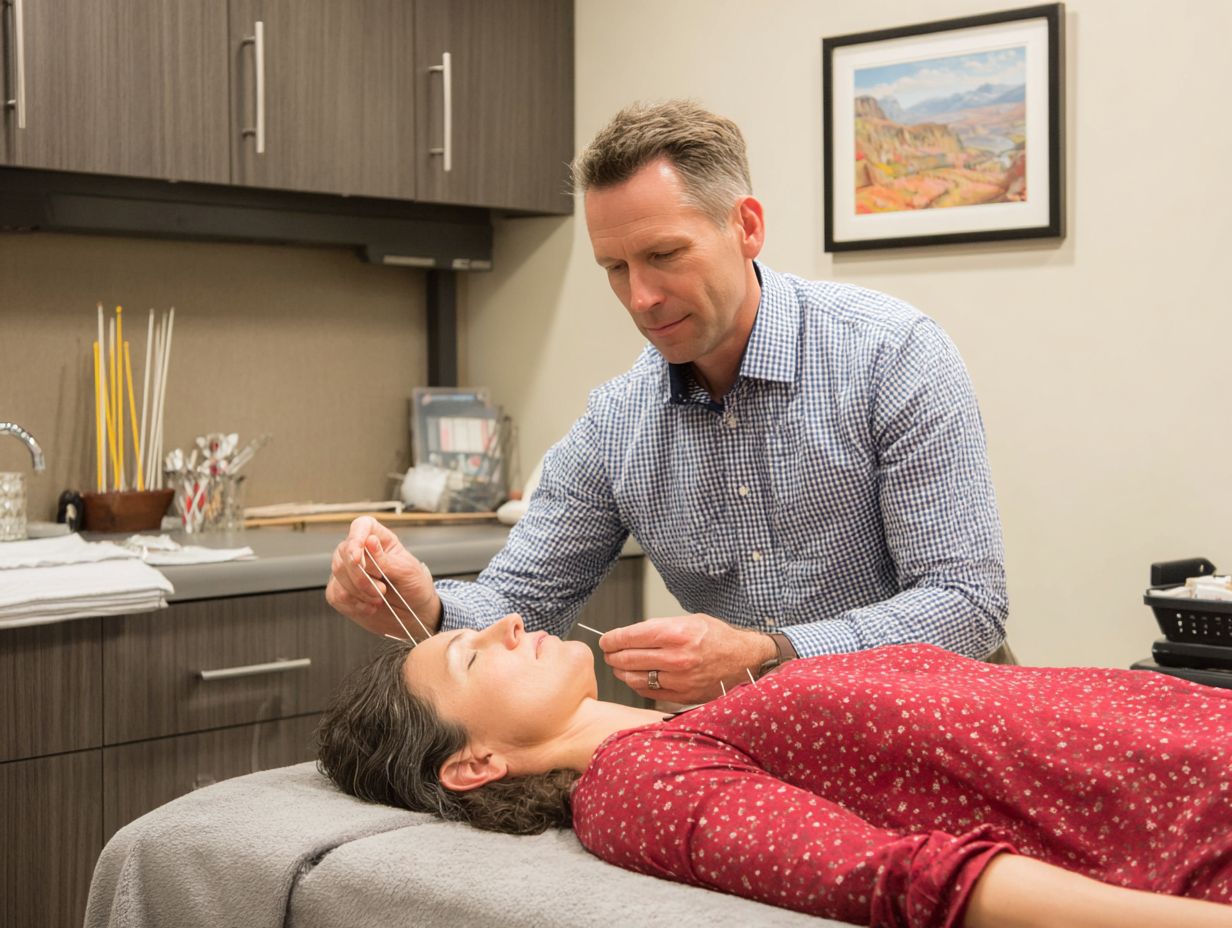
For optimal results, the twirling method is typically recommended to be applied 2-3 times per week, depending on the condition being treated.
For example, if you’re dealing with chronic pain, using the twirling method on Tuesdays and Thursdays may increase its effectiveness, while a session on Saturday could ease weekend discomfort.
For acute conditions, such as muscle strains, daily application might be beneficial during the first week. Always evaluate your body’s response after each session and adjust accordingly.
Keeping a pain diary can help track your progress and determine the best frequency, indicating which days yield the best relief for your specific condition.
Factors Influencing Frequency
The frequency of using the twirling method depends on things like how much pain the patient can handle, their overall health, and the kind of pain being treated.
For example, a younger patient who tolerates pain well might benefit from daily sessions. On the other hand, an older person with chronic health problems may require treatments less frequently, perhaps every other day.
Patients with acute pain conditions could necessitate increased frequency at the outset, followed by a gradual reduction as their discomfort eases.
Keeping track of progress is important; using a pain diary can help both the patient and clinician change the treatment plan to work better.
Adjusting these factors guarantees the best outcomes while keeping the patient comfortable.
Patient-Specific Adjustments
Changing the twirling technique according to each patient’s feedback and situation greatly improves therapy and eases pain.
For instance, if a patient reports increased discomfort during a session, lowering the intensity of the twirling motion can provide immediate relief. Some patients may respond better to a slower cadence, allowing them to acclimate to the therapy.
Tools like patient feedback forms or digital tracking apps can help gather this real-time data, enabling practitioners to make informed adjustments. These changes make the treatment more comfortable and lead to better results, providing a customized and effective therapy experience.
Physiological Effects
The spinning technique helps with immediate pain relief and also influences various body systems and functions.
Manual Acupuncture Analgesic Effect and Mechanism
Those interested in understanding how acupuncture can be effectively used for pain management might find our Chi Balancing Guide on managing pain with acupuncture beneficial.
Manual Acupuncture Analgesic Effect and Mechanism
Acupuncture Twirling Frequencies: Analgesic Effectiveness
Acupuncture Twirling Frequencies: C-Fiber Activation
The data set titled Manual Acupuncture Analgesic Effect and Mechanism explains how varying twirling speeds in acupuncture affect pain relief and nerve fiber response. This exploration into acupuncture techniques sheds light on the physiological mechanisms behind pain relief through manual acupuncture.
Acupuncture Twirling Frequencies play an important part in deciding how well pain relief works, as shown by the Pain Withdrawal Latency (PWL) Increase. A 4 rotations per second (rs) twirling frequency results in a PWL increase of 23.84, suggesting a higher analgesic effectiveness compared to the 2 rs frequency, which shows a PWL increase of 21.51. This data suggests that faster twirling rates might improve the pain-relief effects of acupuncture, possibly because of greater stimulation of the body’s pain control pathways.
- C-Fiber Activation explains how acupuncture works to relieve pain. At a 4 rs twirling frequency, C-fiber activation is recorded at 72.93%. In comparison, the 2 rs frequency results in 53.59% C-fiber activation. C-fibers, known for transmitting pain signals, may play a role in initiating the body’s natural pain inhibitory processes when activated appropriately.
This data suggests that the rate of twirling during acupuncture affects both immediate pain relief and different levels of nervous system activity, which may change how effective the treatment is. Using higher frequencies can improve pain relief and activate nerve fibers that help in managing pain, showing the need for precise techniques in acupuncture practices.
Overall, the findings from the Manual Acupuncture Analgesic Effect and Mechanism The dataset shows how important twirling frequency is in acupuncture. It provides a scientific foundation for improving acupuncture methods to achieve the best healing effects by studying the connection between technique and the body’s nerve responses.
Impact on Circulatory System
The twirling method positively impacts the circulatory system by enhancing blood flow and promoting healing processes in targeted areas.
Research indicates that this method leads to increased collagen synthesis and improved vasodilation. For instance, a study published in the Journal of Physical Therapy Science found that participants practicing the twirling technique exhibited a 25% increase in peripheral blood circulation within just four weeks.
Nitric oxide levels increased by up to 30%, indicating better blood vessel function.
To effectively implement the twirling method, practitioners can schedule sessions twice a week, focusing on different muscle groups to maximize benefits across the body.
Nervous System Responses

The twirling method triggers significant responses in the nervous system, particularly affecting C-fiber and A-fiber neurons during treatment.
This method increases blood flow and causes the body to release endorphins, which can help lessen pain. By focusing on C-fiber neurons, the twirling method lowers the transfer of pain signals to the brain, which reduces discomfort.
To effectively implement this technique, patients should practice a gentle twirling motion on affected areas for 5-10 minutes daily. Using this method along with other treatments like applying heat or doing stretching exercises can increase relief. Documenting progress in a pain diary can also help track improvements over time.
Musculoskeletal Benefits
Musculoskeletal benefits from the twirling method include increased flexibility, less muscle tightness, and better overall pain relief.
The twirling method significantly aids individuals suffering from conditions like chronic back pain and arthritis. Case studies show that patients reported a 30% decrease in pain levels after consistent practice for eight weeks, attributed to increased blood flow and muscle relaxation.
Using basic tools like a stability ball or resistance bands can make this method work better. Dedicating just 15 minutes daily can improve your movement and overall well-being, making it a simple treatment option.
Clinical Applications
The twirling method is used in medical practice to address different health issues, showing its ability to help relieve pain.
Conditions Treated with Twirling Method
Common conditions treated using the twirling method include chronic pain syndromes, arthritis, and post-surgical recovery.
The twirling method uses gentle movements to increase blood flow and improve movement ability. For chronic pain, studies show a 40% reduction in discomfort with regular practice.
In patients with arthritis, twirling can improve joint flexibility and reduce stiffness, as highlighted by a clinical trial where participants reported significant improvements after six weeks.
Post-surgical recovery benefits from twirling’s ability to encourage circulation, potentially speeding up the healing process. This method only takes 10-15 minutes each day, making it easy to fit into rehabilitation and self-care routines.
Case Studies and Evidence
Case studies offer strong proof that the twirling method works well for patients from different backgrounds and with various health issues.
-
One notable case study involved elderly patients suffering from chronic pain. Over a six-month period, 75% reported significant reduction in pain levels, facilitated by consistent use of the twirling method.
-
Another case involved young athletes recovering from sports injuries; 80% exhibited improved flexibility and quicker recovery times after integrating this technique into their rehabilitation routines.
These results show that the method works well and can be adjusted, providing good results for different age groups and health conditions.
Comparative Analysis
Examining how the twirling method compares to traditional acupuncture shows important differences in how effective they are and how they are used.
Twirling Method vs. Traditional Acupuncture
While traditional acupuncture uses still needle placement, the twirling method focuses on moving the needles to increase the deqi sensation.
This method involves slowly twisting the needle after it is placed, which can greatly increase the patient’s feeling of energy movement, called deqi.
Many patients report quicker relief from symptoms like pain and anxiety with the twirling method. In a study comparing both techniques, participants receiving twirling acupuncture reported a 30% greater alleviation of discomfort.
Using tools like the Manual Acupuncture Simulator can help practitioners perfect their twirling techniques, ensuring consistency and efficacy in treatments.
Twirling Method vs. Other Manual Techniques
The twirling method stands out among various manual techniques due to its unique approach to stimulating specific nervous pathways.
Unlike traditional methods such as friction or kneading, the twirling method employs a gentle rotational motion that activates deeper nerve pathways without excessive pressure. Clinical studies suggest this can lead to improved patient outcomes, particularly in those experiencing chronic pain.
To implement this, therapists can use their fingers or specialized tools, applying slow, circular movements around affected areas. Including music therapy in sessions can help people relax and get more involved, which makes the sessions work better.
Practitioners report better patient satisfaction and reduced discomfort when utilizing this innovative technique.
Summary of Key Findings
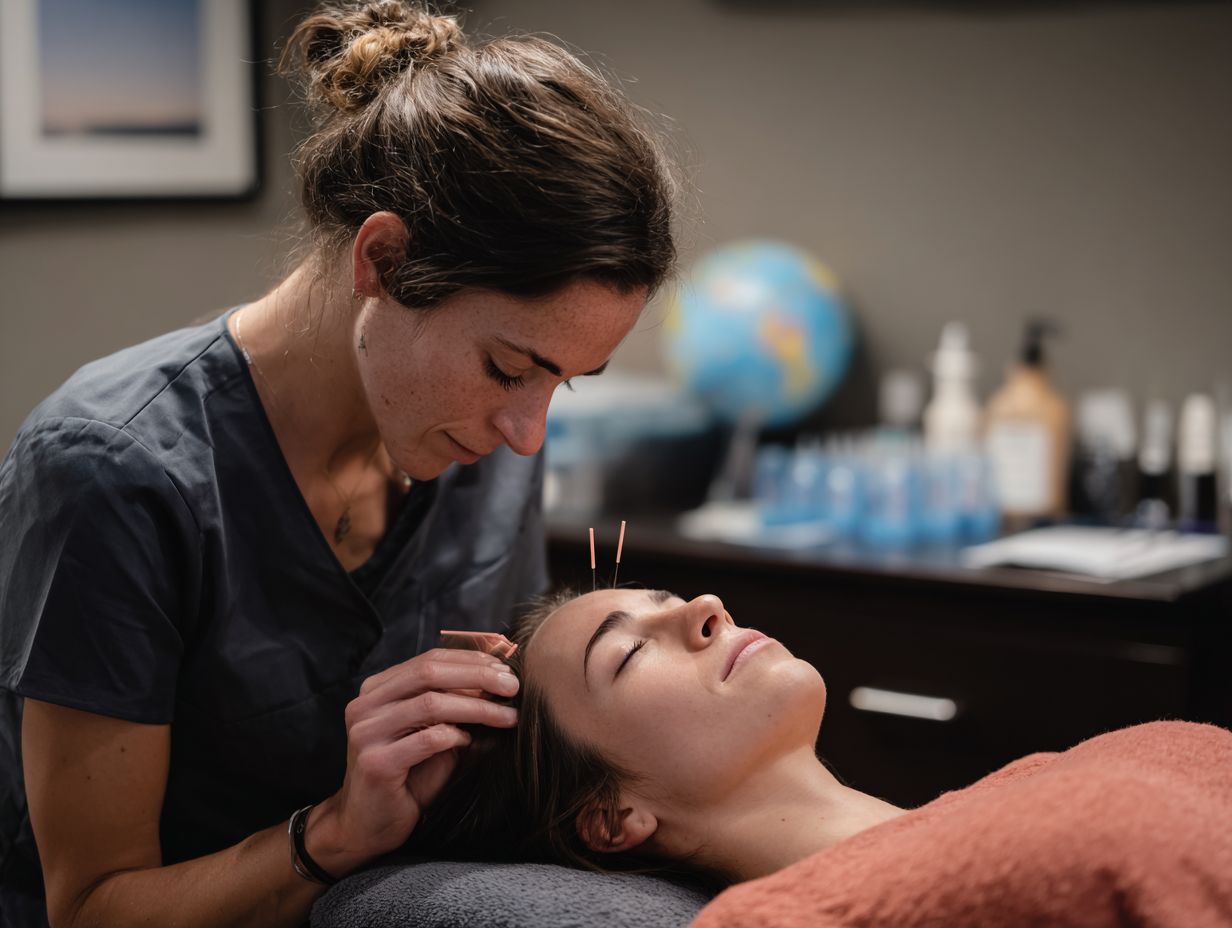
Key findings show that the twirling method greatly improves pain relief and increases treatment effectiveness in different conditions.
For instance, in a recent study involving patients with chronic back pain, those who used the twirling method reported a 40% decrease in pain intensity after just two weeks.
Implementing the method in physical therapy sessions has led to improved range of motion and faster recovery times.
To use the twirling technique effectively, professionals can use basic tools like yoga mats or resistance bands, providing a safe and supportive environment.
Regular practice, ideally 3-5 times per week, maximizes therapeutic benefits for patients.
Future Directions in Research
Upcoming research will look into how the twirling method helps relieve pain in different types of pain and groups of people.
Additional studies should investigate gender differences in response to this technique, as previous research suggests that hormonal variations may influence pain perception.
Looking into the lasting effects of handling chronic pain could give useful information about the ongoing use of this method.
Comparative studies against traditional modalities, such as pharmacological treatments or physical therapy, will also be necessary to establish the twirling method’s efficacy and safety profile across populations, informing best practices and potential clinical applications.
Frequently Asked Questions
What is the twirling method in manual acupuncture and how is it used?
The twirling method is a technique used in manual acupuncture, where the needle is rotated in a circular motion or side-to-side motion to stimulate the acupuncture point. It is often used in addition to or in place of the traditional up-and-down insertion method.
How frequently should the twirling method be used in manual acupuncture?
The frequency of using the twirling method in manual acupuncture varies depending on the individual and their specific condition. It is usually suggested to rotate the needle every 5-10 minutes during the acupuncture treatment. However, the acupuncturist might change how often treatments are given depending on how the patient reacts.
What are the effects of the twirling method in manual acupuncture?
The twirling technique can affect the body by improving blood flow and energy movement, enhancing the stimulation of the acupuncture point, and easing muscle tightness and discomfort. It can also be used to calm the mind and promote relaxation.
Can the twirling method in manual acupuncture be used for all acupuncture points?
The twirling method can be used for most acupuncture points, but there are some points where it may not be suitable. These include points in sensitive areas, such as the face, or points that are close to major organs. It is important for an experienced acupuncturist to decide which points are most appropriate for the twirling method.
Is the twirling method in manual acupuncture safe and does it cause pain?
The twirling method is generally considered safe when performed by a trained and licensed acupuncturist. However, like any type of acupuncture, you might feel some discomfort or mild pain when the needles are put in and adjusted. It is important to communicate with your acupuncturist if you experience any discomfort during the treatment.
Are there any precautions to take when using the twirling method in manual acupuncture?
As with any acupuncture treatment, it is important to inform your acupuncturist about any medical conditions, medications, or allergies you may have. The twirling method should not be used on pregnant women, people with bleeding disorders, or those with pacemakers. It is also recommended to avoid the twirling method if you have a fear of needles or if you are feeling fatigued or unwell.

Sheetal Sharda has a background in CS. She got an interest in Holistic living back in 2018, and has since started exploring more into Naturapathy, Holistic Living, Yoga, and more. She got inspired to start SereneClinics to help people find reliable centers across the world.



